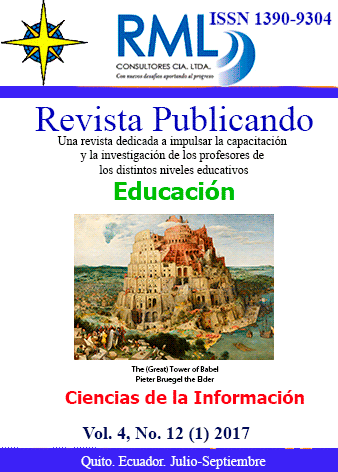Abstract
Formative Assessment plays a highly important practice in the teaching and learning process where English is taught as a second language (ESL) and as a foreign language (EFL). However, Formative Assessment has not been paid major attention as Summative Assessment has in the Ecuadorian Education System. The purpose of the study is to describe the perception that English students and English teachers have about Formative Assessment and Formative Feedback in their every day practice. A total of 70 students majoring in different engineering and 10 English teachers participated in this study. We used data collected from class observation, questionnaires, and interviews in these cases, with a qualitative ethnographic approach, the sources were english teachers and students from Pre-intermediate and Intermediate levels of Higher Education. The findings show that in both Language Centers students appreciated that their teachers use Formative Assessment and Formative Feedback in their classes. In the Language Center of the Technical University of Ambato, Interviews were used to give feedback or correct common mistakes. We did Interviews in English with the Pre-Intermediate Level of the Open modality. On the other hand, we used Interviews in Spanish with the Intermediate Level of the Army Polytechnic School, Campus Latacunga. Students found Formative Feedback fruitful to develop language and promote meaningful learning. We can also say that Spanish Interviews were more useful that English interviews. However, there was a slight difference among English teachers. Three from ten teachers who had large classes of 30 or 35 students, said that Formative Feedback was somewhat challenging because it involved lots of class observation and provide permanent feedback to low achievers”™ performance during Instruction. This paper concludes with the authors”™ reflection and it highlights the benefits of applying Formative Assessment and Formative Feedback in Teaching English as a Foreign Language (EFL).
References
Allal, L. (1997). “La mesure : variations culturelles sur le thí¨me ADMEE”, Mesure et évaluation en éducation. 1-4.
Allal, L., & Lopez, L. M. (2005). Formative assessment of learning: A review of publications in French. . Formative assessment: Improving learning in secondary classrooms., 241-264. Obtenido de Formative Assessment of Learning: A review of publication in French: http://www.oecd.org/edu/ceri/34260447.pdf
Audibert, S. (1980). “En d”™autres mots ... l”™évaluation des apprentissages ! . Mesure et évaluation en éducation, 59-64.
Bailey, R., & Garner, M. (2010). Is the feedback in higher education assessment worth the paperit is written on? Teacher ´s reflections on their practices. Teaching in Higher Education, 15(2), 187-198.
Black, P., Harrison, C., Lee, C., Marshall, B. & Wiliam, D. (2003). Assessment for learning:putting it into practice. Maidenhead: Open University Press, 58-64.
Bloom, B. (1969). Frmative Assessment: Getting the Focus Right (PDF). Obtenido de https://www.researchgate.net/publication/248940867_Formative_Assessment_Getting_the_Focus_Right [accessed Aug 22, 2017].
Bloom, B. S. (1969). Some theoretical issues relating to educational evaluation. In R. W. Tyler (Ed.), Educational evaluation: new means:63rd yearbook of the National Society for the Study of Education ( part II). Chicago: University Of Chicago Press.
Brookhart, S. M. (2008). How to give effective feedback to your students.
Butler, R. (1988). Enhancing and undermining intrinsic motivation; the effects of task-involving evaluation on interest and performance. British Journal of Educational Psychology, 1-14.
Chappuis, J. (2005). Helping students understand assessment. Educational Leadership, 63 (3): 39–43.
Chaudron, C. (1988). Second Language Classrooms: Research on Teaching and Learning. New York: Cambridge university Press.
Hughes, A. (2003). Testing Language Teachers. Cambridge: Cambridge University Presss.
Kathleen, C. M & McMillan. J. H. (2010). "Formative Assessment Techniques to Support Student Motivation and Achievement.". The Clearing House, 83.
Nash, G., Liebergreen, M., Crimmins, G., Turley, J., & Bond, R. (2012). First Feedback Face-to-face (FFF): assessing a first-year initiative for providing formative feedback on assessment and promoting student self-regulated learning. (págs. 1-5). Queensland, Australia: Queensland University of Technology.
Potter, A & Lynch, K. ((2008)). Quality Feedback on Assessment: Apple for the Teacher? How First Year Student Perceptions of Assessment Feedback Affect Their Engagement with study, conference proceedings. 11th Pacific Rim First year in Higher Education Conference. Tasmania: Hobart.
Sadler, D. R. (1989). Formative assessment and the design of instructional.
Sambell, K., McDowell, L., & Montgomery, C. (2012). Assessment for learning in higher education. . Routledge.
Scriven, M. (1967). “The Methodology of Evaluation”. AERA Monograog Series on Evaluation, 39-83.
Strenger, M. (13 de February de 2014). 5 Research-BasedTips for Providing Students with Meaningful Feedback. Obtenido de https://www.edutopia.org/blog/tips-providing-students-meaningful-feedback-marianne-strenger
Ur, P. (2009). A course in Language Teaching. Practice and theory. Cambridge: Cambridge Uuniversity Press.
You are free to:
Share — copy and redistribute the material in any medium or format.
Adapt — remix, transform, and build upon the material.
The licensor cannot revoke these freedoms as long as you follow the license terms.
Under the following terms:
Attribution — You must give appropriate credit, provide a link to the license, and indicate if changes were made. You may do so in any reasonable manner, but not in any way that suggests the licensor endorses you or your use.
NonCommercial — You may not use the material for commercial purposes.
ShareAlike — If you remix, transform, or build upon the material, you must distribute your contributions under the same license as the original.
No additional restrictions — You may not apply legal terms or technological measures that legally restrict others from doing anything the license permits.
